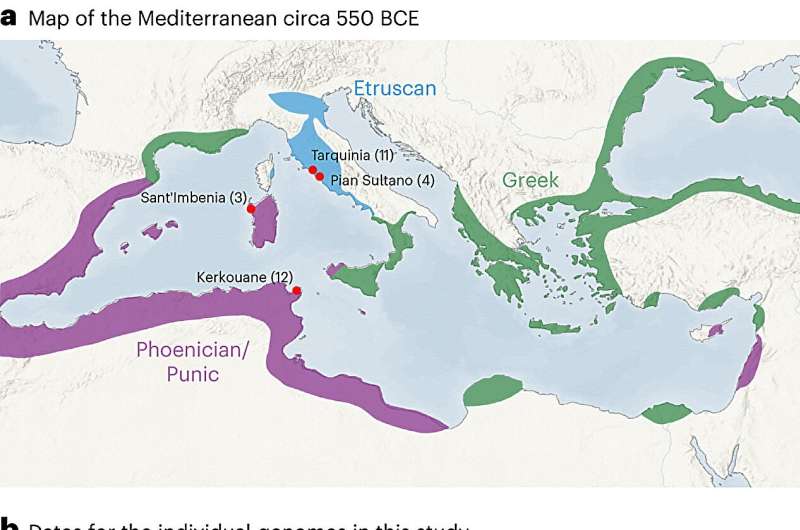August 18, 2023 report
This article has been reviewed according to Science X's editorial process and policies. Editors have highlighted the following attributes while ensuring the content's credibility:
fact-checked
peer-reviewed publication
trusted source
proofread
Sequencing genes of Iron and Bronze Age peoples to better understand early Mediterranean migration patterns

An international team of anthropologists, archaeologists and geneticists has learned more about the migration patterns of people living around the Mediterranean Sea during the Iron and Bronze ages. In their study, reported in the journal Nature Ecology & Evolution, the group conducted genetic sequencing on the remains of 30 people who lived during the Iron or Bronze Age in Sardinia, Tunisia and mainland Italy.
As the researchers note, most knowledge of people living around the Mediterranean Sea during the Iron and Bronze Ages derives from study of artifacts they left behind. But such evidence, they point out, does not reveal much about the backgrounds of those people or where their ancestors came from. In this new effort, the research team sought to learn more about the backgrounds of such people by following migration patterns using genetic sequencing.
The researchers conducted shotgun sequencing (sequencing conducted in random fashion) on samples collected from unearthed bones of ancient people living in Italy, Tunisia and Sardinia to get a sense of migration patterns for people living in the northern, central and southern parts of the eastern part of the Mediterranean during the Iron and Bronze Ages—a time, the researchers note, when people were traveling greater distances due to advances in boat and shipbuilding. The team then compared their findings to the results of other sequencing efforts conducted on both modern and ancient peoples living in the region.
They found evidence of widespread migration around the Mediterranean, suggesting strong ties between distant people. They also found heterogeneity in Iron Age populations and shifts in ancestry in North Africa and Sardinia during the Bronze Age, suggesting an uptick in migration. More specifically, the research revealed an increase in migration from what is now Morocco and Iran by neolithic farmers to both Sardinia and Tunisia, and somewhat less migration to what is now Italy.
The research team suggests that there was an increase in migration, as expected during both the Iron and Bronze Ages, as people sailed the Mediterranean Sea for a myriad of reasons—and in so doing, shaped the ancestry of those who lived in the region.
More information: Hannah M. Moots et al, A genetic history of continuity and mobility in the Iron Age central Mediterranean, Nature Ecology & Evolution (2023). DOI: 10.1038/s41559-023-02143-4. On bioRxiv: www.biorxiv.org/content/10.110 … /2022.03.13.483276v3
Journal information: Nature Ecology & Evolution , bioRxiv
© 2023 Science X Network




















